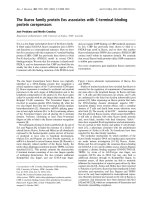Báo cáo y học: "The high-risk surgical patient revisited" docx
Bạn đang xem bản rút gọn của tài liệu. Xem và tải ngay bản đầy đủ của tài liệu tại đây (172.04 KB, 2 trang )
COMMENTARY
The high-risk surgical patient revisited
David Bennett
2cc-2-1-001
Full text
The results of the various sepsis intervention studies and
doubts about the efficacy of the pulmonary artery (PA)
catheter have cast a considerable shadow over the inten-
sive care community. They serve to highlight the impor-
tance of the recent paper published by Sinclair et al [1],
in which the authors convincingly demonstrated that
elderly patients undergoing surgery for a fractured neck
of femur had a slightly significantly better outcome if
they were aggressively volume loaded with coll oid
intraoperatively. They showed that the administration of
an average of 750 ml of colloid during t he course of the
operation resulted in a highly significant reduction in
hospital stay and a lower complication rate. The well-
matched control group patients were treated conven-
tionally, only receiving crystalloid.
The range of volumes of colloid given to the protocol
group of patients was considerable, and the cardiovascu-
lar effects of the infusion were monitored using an intra-
oesophageal Doppler device which measures descending
aortic blood velocity and converts it into cardiac output
using a built-in nomogram. Sinclair et al showed that,
following colloid infusion, the protocol group of patients
had significantly increased cardiac output and stroke
volume when compared to their own baseline values and
the control patients. This simple manoeuvre led to a 39%
reduction in hospital stay and complication rate.
The obvious question i s, could they have achieved the
same result simply by administering t he volume of col-
loid without monitoring cardiac output, albeit with a
relatively noninvasive device that is placed in the oeso-
phagus. This is an important question because it is likely
to determine whether such an approach to the manage-
ment of similar h igh-risk patients will be generally
accepted and become the standard.
Others, including Shoemaker et al [2], Boyd et al [3]
and more recently Bishop et al [4], have clearly shown
that the recognition and very early optimisation of car-
diac output in a wide range of high-risk surgical patients
produces highly significant reductions in both morbidity
and mortality. This approach is time consuming and
requires, in some cases, admission to the intensive care
unit some hours prior to surgery and the insertion of
PA catheters for the measurement and manipulation of
cardiac output. This makes the approach unattractive to
many clinicians, with their doubts being further ampli-
fied by the recent controversies. Shoemaker et al (pers
comm) have estimated that as many as 8-10% of all sur-
gical patient s should be considered at high risk from
develop ing significan t post-operative morbidity and
mortality. These patients warrant further extensive study
and the Sinclair investigation is a welcome a ddition to
the growing list of papers that demonstrate the bene fits
that can be obtained with this approach.
In general, the recent consensus meeting on efficacy of
PA catheters [5] was unable to identify studies which
offered scientific evidence that their use leads to clini cal
benefit, despite the fact that there is an annual wor ld
usage well in excess of 2 million, with the USA account-
ing f or the large majority. The only area where benefit
could in any way be ascribed to the use of the PA cathe-
ters was in those who fulfi lled the criteria for being
defined as high-risk surgical patients. In this group of
patients the consensus felt there was evidence to suggest
that systematically increasing oxygen delivery in the pre-
operative period leads to significant improvement in
both mortality and morbidity.
In most of the work identified, the increase in cardiac
output was monitored using a PA catheter althou gh two
of the studies used the oesophagus Doppler instrumen-
tation. Clearly the use or not of PA catheters arouses
strong emotions and will undoubtedly continue to do so
until the appropriate efficacy trials are undertaken. It is
to be hoped that any such trials must include the cate-
gory of high-risk surgical patients that statistically bene-
fit from the insertion of a PA catheter. In addition, we
should address the further question of whether alterna-
tive techniques for measuring cardiac output, including
intra-oesophageal Doppler and indeed impedence
plethysmography, are viable clinica l alternatives to the
PA catheter.
Department of Intensive Care, St George’s Hospital,Blackshaw Road, London
SW17 0QT, UK
Bennett Critical Care 1998, 2:1
©1998CurrentScienceLtd
Published: 12 March 1998
References
1. Sinclair S, James S, Singer M: Intraoperative intravascular volume
optimisation and length of stay after repair of proximal femoral fracture:
randomised controlled trials. Br Med J 1997, 315:909-912.
2. Shoemaker WC, Appel Pl, Kram HB, Waxman K, Lee TS: Prospective trial of
supranormal values of survivors as therapeutic goals in high-risk surgical
patients. Chest 1998, 94:1176-1186.
3. Boyd O, Grounds RM, Bennett ED: A randomised controlled trial of the
effect of deliberate preoperative increase of oxygen delivery on
mortality and morbidity in high-risk surgical patients. JAMA 1993,
270:2699-2707.
4. Bishop MU, Shoemaker WC, Appel PL, et al: Prospective randomised trial
of survivor values of cardiac index. Oxygen delivery and oxygen
consumption as resuscitation endpoints in severe trauma. Trauma 1995,
38:780-787.
5. : Pulmonary Artery Catheter Consensus Conference: consensus
statement. Crit Care Med 1997, 25:910-925.
doi:10.1186/cc116
Cite this article as: Bennett: The high-risk surgi cal patient revisited.
Critical Care 1998 2:1.
Submit your next manuscript to BioMed Central
and take full advantage of:
• Convenient online submission
• Thorough peer review
• No space constraints or color figure charges
• Immediate publication on acceptance
• Inclusion in PubMed, CAS, Scopus and Google Scholar
• Research which is freely available for redistribution
Submit your manuscript at
www.biomedcentral.com/submit
Bennett Critical Care 1998, 2:1
Page 2 of 2









